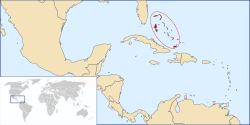From Wikipedia, the free encyclopedia
(Redirected from
Bahamas)
| Commonwealth of The Bahamas |
|---|
|
| Motto: "Forward, Upward, Onward, Together" |
Anthem: "March On, Bahamaland"
Royal anthem: "God Save the Queen" |
|
Capital
(and largest city) | Nassau
 25°4′N 77°20′W / 25.067°N 77.333°W / 25.067; -77.333 25°4′N 77°20′W / 25.067°N 77.333°W / 25.067; -77.333 |
| Official language(s) | English |
|---|
| Recognised regional languages | Bahamian Creole |
| Ethnic groups | 85% Africans, 12% Europeans, 3% Asians |
| Demonym | Bahamian |
|---|
| Government | Parliamentary democracy and Constitutional monarchy |
|---|
| - | Monarch | Queen Elizabeth II |
| - | Governor-General | Sir Arthur Foulkes |
| - | Prime Minister | Hubert Ingraham |
| Legislature | Parliament |
|---|
| - | Upper House | Senate |
| - | Lower House | House of Assembly |
| Independence | from the United Kingdom |
|---|
| - | Self-governing | 1865 |
| - | Full independence | July 10, 1973[1] |
| Area |
|---|
| - | Total | 13,878 km2 (160th)
5,358 sq mi |
| - | Water (%) | 28% |
| Population |
|---|
| - | 2009 estimate | 330,000[2] (177th) |
| - | 1990 census | 254,685 |
| - | Density | 23.27/km2 (181st)
60/sq mi |
| GDP (PPP) | 2009 estimate |
| - | Total | $8.793 billion[3] |
| - | Per capita | $25,807[3] |
| GDP (nominal) | 2010 estimate |
| - | Total | $7.538 billion[3] |
| - | Per capita | $22,650[3] |
| HDI (2010) |  0.784[4] (high) (43rd) 0.784[4] (high) (43rd) |
| Currency | Bahamian dollar (BSD) |
|---|
| Time zone | EST (UTC−5) |
|---|
| - | Summer (DST) | EDT (UTC−4) |
| Drives on the | left |
|---|
| Internet TLD | .bs |
|---|
| Calling code | +1-242 |
|---|
The Bahamas (pronounced
/ðə bəˈhɑːməz/ ( listen)
listen)), officially the
Commonwealth of the Bahamas, is a country consisting of 29
islands, 661
cays, and 2,387
islets (rocks). It is located in the
Atlantic Ocean north of
Cuba and
Hispaniola (
Dominican Republic and
Haiti), northwest of the
Turks and Caicos Islands, and southeast of the
United States (nearest to the state of
Florida). Its total land area is 13,939 km
2 (5,382 sq mi), with an estimated population of 330,000. Its capital is
Nassau. Geographically, the Bahamas lie in the same island chain as Cuba, Hispaniola and the Turks and Caicos Islands; the designation of Bahamas refers normally to the commonwealth and not the geographic chain.
Originally inhabited by the
Lucayans, a branch of the
Arawakan-speaking
Taino people, The Bahamas were the site of Columbus' first landfall in the New World in 1492. Although the Spanish never colonized The Bahamas, they shipped the native Lucayans to slavery in Hispaniola. The islands were mostly deserted from 1513 to 1648, when
British colonists from
Bermuda settled on the island of
Eleuthera.
The Bahamas became a
Crown Colony in 1718 when the British clamped down on
piracy. Following the
American War of Independence, thousands of pro-British loyalists and enslaved Africans moved to The Bahamas and set up a plantation economy. The
slave trade was abolished in the
British Empire in 1807 and many Africans liberated from slave ships by the
Royal Navy were settled in The Bahamas during the 19th century. Slavery itself was abolished in 1834 and the descendants of enslaved and liberated Africans form the bulk of The Bahamas's population today.



No comments:
Post a Comment